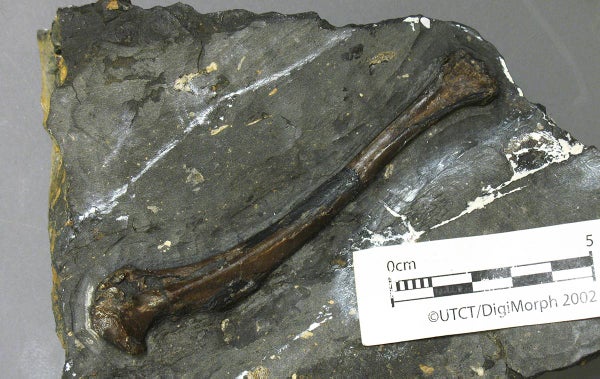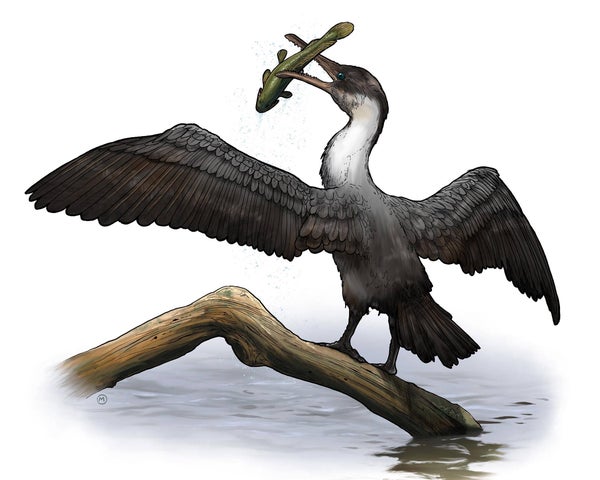This article was published in Scientific American’s former blog network and reflects the views of the author, not necessarily those of Scientific American
The word "dinosaur" conjures up images of something sturdy. Massive animals held up by enormous bones, with femora taller than you are, that have survived tens or hundreds of millions of years in the rock. This isn't wrong, but it's too narrow. Not all dinosaurs were like this, and some - much to the consternation of paleontologists - were incredibly fragile. The light skeletons that allowed avian dinosaurs to take to the air, for example, also made birds less likely to survive the fossilization process than some of their giant cousins. The discovery of any Mesozoic bird bone is a cause for at least a minor celebration, even more when it highlights the existence of a species we never knew about before.
A nearly-complete humerus, or upper arm bone, and a pair of additional arm fragments have led paleontologist Richard Bono and colleagues to name a new species of 92 million-year-old bird. They've called it Tingmiatornis arctica, and it currently has pride of places as one of the oldest bird fossils in North America.
Although birds split from their other dinosaurian relatives by about 150 million years ago, the record of their early days is relatively sparse. They were small, fragile things. But while an arm bone and a pair of additional pieces might not seem like much, Bobo and coauthors report that Tingmiatornis is a significant find from an exceptional place and time. Found on Nunavut, within the High Arctic, the Cretaceous bird enjoyed a much warmer climate than prevails today. The weather was absolutely balmy - there was no seasonal ice, and annual temperatures had an average minimum of 57°F.
From the anatomy of the arm bones, Bono and colleagues expect that Tingmiatornis was a cormorant-like bird. This fits the ecology of the area previously pieced together from the rock and other fossils. The deposits the bird was found in represent freshwater environments that were home to superficially crocodile-like animals called champsosaurs, juvenile plesiosaurs, and a wealth of fish. It was an Arctic paradise, and its easy to imagine Tingmiatornis gobbling its fair share of piscine prey.

The humerus of Tingmiatornis. Credit: John Tarduno University of Rochester
Fossil Facts
On supporting science journalism
If you're enjoying this article, consider supporting our award-winning journalism by subscribing. By purchasing a subscription you are helping to ensure the future of impactful stories about the discoveries and ideas shaping our world today.
Name: Tingmiatornis arctica
Meaning:Tingmiatornis is a combination of Inuktitut for "those that fly" and the Greek word for bird, and arctica refers to the northern latitude of the bird's ancient habitat.
Age: Cretaceous, 92 million years ago.
Where in the world?: Nunavut, Canada.
What sort of critter?: A bird.
Size: Unknown, but likely comparable to fish-eating birds like cormorants
How much of the creature’s body is known?: A complete humerus, part of an ulna, and part of another humerus.
Reference:
Bono, R., Clarke, J., Tarduno, J., Brinkman, D. 2016. A large ornithourine bird (Tingmiatornis arctica) from the Turonian High Arctic: Climatic and evolutionary implications. Scientific Reports. doi: 10.1038/srep38876
Previous Paleo Profiles:
The Light-Footed Lizard The Maoming Cat Knight’s Egyptian Bat The La Luna Snake The Rio do Rasto Tooth Bob Weir's Otter Egypt's Canine Beast The Vastan Mine Tapir Pangu's Wing The Dawn Megamouth The Genga Lizard The Micro Lion The Mystery Titanosaur The Echo Hunter The Lo Hueco Titan The Three-Branched Cicada The Monster of Minden The Pig-Footed Bandicoot Hayden's Rattlesnake Demon The Evasive Ostrich Seer The Paradoxical Mega Shark The Tiny Beardogs The Armored Fish King North America's Pangolin The Invisible-Tusked Elephant The Mud Dragon The Spike-Toothed Salmon The Dream Coast Crocodile Buriol's Robber Ozimek's Flyer The Northern Naustoceratopsian
